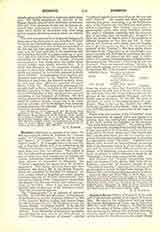

Eusebius, CHRONICLE OF, consists of two parts: the first was probably called by Eusebius the “Chronograph” or “Chronographies”; the second he terms the “Canon”, or “Canons”, and also the “Chronological Canons”. It is brought down to the year 225, and as Eusebius alludes to it at an earlier date in the “Eclogae Prophetic” and “Prieparatio Evangelica” there must have been two editions. The original is lost, but both parts are preserved in an Armenian version of which two rival translations by Zohrab and Aucher, respectively, were published in 1818. Both these editions are superseded by Schoene’s. The “Canons”, moreover, are preserved in St. Jerome’s translation. Two Syriac epitomes have also been published, one from a MS. in the British Museum, which was translated by Roediger for Schoene’s edition, another edited by Siegfried and Gelzer (Eusebii Canonum Epitome ex Dionysii Telmaharensis Chronico petita, Leipzig, 1884). Considerable extracts from the original were also preserved by later writers, especially by Syncellus. These it has been possible to identify since the discovery of the Armenian version. They will be found in Schoene.
The “Chronography” is an epitome of universal history. It is divided into five parts: (I) the history of the Chaldeans, and the Assyrians, followed by lists of the Assyrian, Median, Lydian, and Persian kings; (2) Old Testament history; (3) Egyptian history; (4) Grecian history; (5) Roman history. It is, like the “Praeparatio Evangelica”, full of quotations from lost authors. As an illustration of its value in one particular province we may turn to the third chapter of Smith’s “Chaldean Account of Genesis“, entitled “Chaldean Legends transmitted through Berosus and other Authors”. The longest and most important extracts here given, containing, e.g. the Babylonian story of the Creation and the Flood, owe their preservation to Eusebius. The “Canons” are a series of chronological tables with short historical notices. The years of Abraham, beginning from the supposed date of his birth, form the backbone. Alongside of these are placed the regnal years of the monarchs of different kingdoms as they rose and fell. A single extract will, however, serve better than any description to give the reader an idea of the character and contents of the “Canons”. We have shown above the value of the “Chronicle” to an Assyriologist; our second example will illustrate its importance for classical scholars. On almost the first page of Jebb’s edition of the newly discovered poems of Bacchylides, the notices in the “Chronicle” concerning the poet are discussed. There are two such notices. We give the first with its context, as it is found in the facsimile of the Bodleian MS. of St. Jerome’s version:—
LXXVIII Olymp. Herodotus historiarum scriptor agnoscitur.
XVIII Bacchylides et Diagorus atheus XXXVI
sermone plurimo celebrantur
MDL. XVIIII Zeuxis pictor agnoscitur, etc. XXXVII
From the above we learn that Bacchylides became renowned in the 18th year of Xerxes, King of Persia, the 36th of an Alexander, King of Macedonia, the beginning of the seventy-eighth Olympiad, and the 1549th year of Abraham. In this MS. the years of Abraham are given at the commencement of every decade. Thus, in the last line, the first year (MDL) marks the opening of a new decade; while the second year (XVIIII) shows the continuation of the reign of Xerxes.
Which of the two versions of the “Chronicle” is the more trustworthy as regards dates and figures is a question that was conclusively answered in favor of the Latin version by Lightfoot in his excursus, “The Early Roman Succession”. The striking differences between the episcopal lists (notably the Roman) as they are found in the Armenian version, on the one hand, and in the Latin version and “The Church History”, on the other hand, give rise to a number of ingenious theories concerning changes made by Eusebius in a later edition of his “Chronicle”. Lightfoot annihilated these theories by demonstrating the corrupt state of the Armenian version in all that relates to figures and the years to which different events are assigned. It is important to remember this in reading books or articles in which reference is made to the “Chronicle”, if they were written before 1890.
Best Editions.—(I) “Eusebii Chronicorum Libri duo”, ed. Schoene, 2 vols., Berlin, 1866-1875; (2) the Bodleian manuscript of Jerome’s version of the “Chronicle of Eusebius”, reproduced in collotype with an introduction by John Knight Fotheringham, M. A., Oxford, 1905; (3) the Syriac epitomes referred to above.
F. J. BACCHUS

